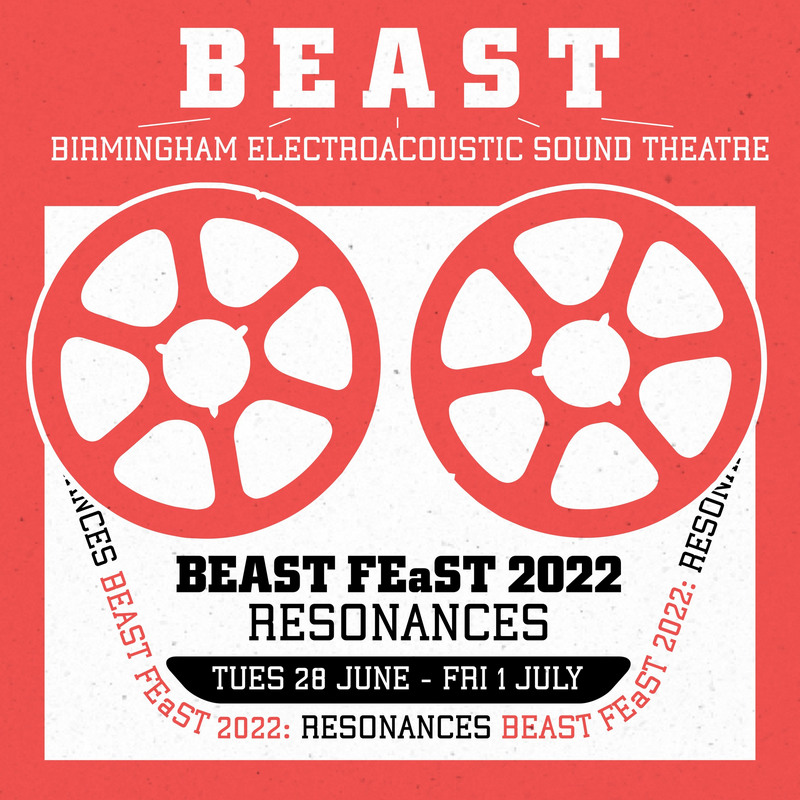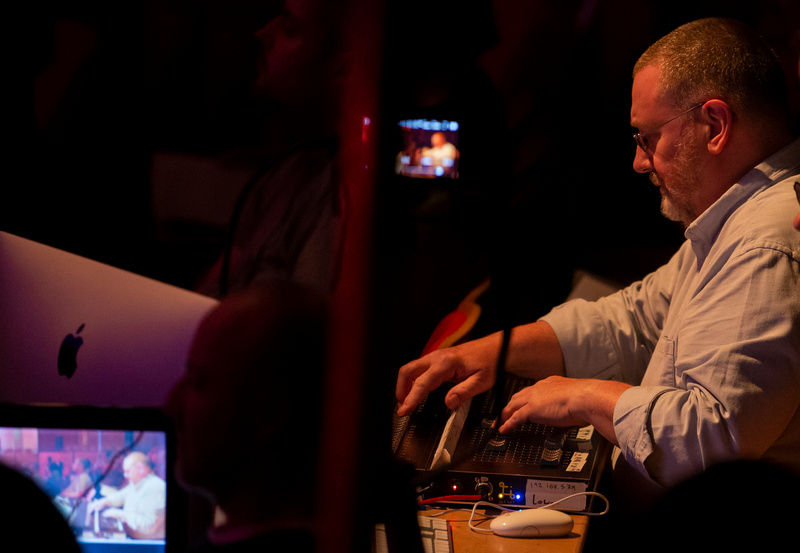
In the previous part i highlighted the works heard at BEAST FEaST 2022 that went against the grain and handled their materials with gentleness. However, not surprisingly the dominant compositional attitude was one aspiring to power and heft. Though unassumingly titled, Helena Gough‘s Yolk featured an almost flamboyant display of muscular energy in a work that, unlike some, was judged perfectly in terms of duration, knowing just how long to keep this up. James Carpenter did something similar in Tangle but in 8-channels (used very effectively). With a compelling narrative, building sequences of tension and at times accumulating huge dense walls, the piece suggested a rapid pulse and timelessness simultaneously. An abandoned piano was the subject of Julien Guillamat‘s Les marteaux oubliés, a gleeful study of its dilapidated twang and plunk which on more than one occasion appeared to have been destroyed in a tumult. Though Guillamat appeared to be lightening the intensity, another crash reduced the beleaguered instrument into a knackered chorus of thrummed notes and chords. It was all gloriously messy. Peter Batchelor focused on pinball machines in Kaleidoscope: Arcade, in a kinetic but measured music that sounded as if its feisty gestures of punch and clank were happening spontaneously, like mechanical will-o’-the-wisps. The conclusion was marvellous, unexpectedly dissolving into sustained radiance.

An advantage of some of these works was keeping the clarity of sounds at a distance. Hector Bravo Benard‘s Interlude took the form of a large, unstoppable slab of stuff, its nebulosity nicely coloured by hints of something organ-like within before being swallowed up. Yet more tantalising was Jorge Gregorio García Moncada‘s Psittacus, a compelling slow-burn that gradually coalesced into a glowering bass pulse with high chitterings. Growing further, the work’s climactic sequence was filled with almost identifiable objects caught in a swirling halo of dynamism.
The most powerful works of all were irresistibly energising. Simon Smith brought to mind the random squall of FURT in Synthetic RADI (reactive-affective-defensive-impulsive), a work conveying a real sense of struggle. Smith’s music was acutely tactile, his material strenuously pulled, twisted, contorted and mangled, a process given poignancy in the way voice-like sounds protruded from within. Figures d’espace by Annette Vande Gorne was also hugely physical, to the extent that in its third section it sounded as if the entire Elgar Concert Hall was preparing to blast off into the sky. This was matched by a beautifully judged, incredibly vivid melding of acoustic and electronic sounds such that nothing seemed abstract. Especially impressive were assorted forms of air pressure that appeared later on, ranging from puffs to blasts, and pitch as the apparent product of extreme acts of bending and bouncing.
Only two pieces involved something other than electronics. Duncan Forsyth-Forrest‘s Tenney for soprano saxophone and electronics created an air noise texture that gradually yielded to dronal multiphonics. Stable and restful, it was an like an extended scrutiny of circular breathing. Much more ambitious was MotorBEAST, by BEAST co-director Scott Wilson, featuring a tuba sextet. Though the distinction between acoustic and electronic was usually clear, Wilson nonetheless superbly integrated the tubas with the electronics, making everything sound as if it were part of the same sonic spectrum. Rich tuba chords, often beating wildly from dissonant clashes, were extended outwards and upwards by the electronics, sometimes garnished with glitter, and towards the end everything became a network of rising and falling whistles.
An especially interesting aspect of the festival’s retrospective angle was the contrast evident in music by acousmatic legends François Bayle and Bernard Parmegiani. Bayle’s 1970 Toupie dans le ciel demonstrated a much broader and more holistic sense of musical thought, with a clear sense of ideas being presented, developed, even somewhat recapitulated. The impression of multiple interconnected layers moving discretely, the overall effect like the breathing of a strange machine, was as arresting now as it was over half a century ago. Parmegiani’s 1971 La Roue Ferris reiterated the point i made in Part 1 concerning the degree to which so much of more recent acousmatic music uses extremely similar timbres and gestures. Here was something genuinely different, circling patterns channelled into a looming dronal accumulation, cycling round, constantly poised, as if it could explode at any moment.
Most impressive of all, though, was the trio of works presented by Robert Normandeau. The concert devoted to his music arguably deserves an entire article to itself. In a pre-concert talk, Normandeau had highlighted the distinction between localisation, the attempt to place sounds at specific locations, and spacialisation, surrounding and enclosing the listener within a sonic environment. The latter of these, Normandeau said, was what he was interested in, and this was overwhelmingly evident in all three pieces. StrinGDberg made a humble hurdy-gurdy the starting point for an entire universe of sound, though in so subtle a way that one hardly realised it was happening. Individual notes became soft pulsations and hints of melody… and in no time had transformed and expanded into a transcendent pulsating and radiating, filling the Dome Room with warmth and colour.

Another amazing transition occured in Raíl, initially obviously railway-related but soon blurred and complicated, becoming an intricate amalgam of pitch, noise, buzz, throb, air and clatter, tilting between abstraction and delicate hints of its concrete origins. It was absolutely mesmerising. L’engloutissement took inspiration from an occasion when the composer almost drowned. Mercifully, Normandeau didn’t seek to replicate that terrifying prospect but instead presented a kind of stylised maelstrom into which we were repeatedly plunged. Distant strains of gulls appeared, but the emphasis was on the shifting make-up of the subaquatic turbulence, initially a torrent of noise, later a convoluted pitch aggregation polarising into abyssal bass and tinnital ringing. This concert was the best, and the most overwhelming, demonstration of multichannel work during BEAST FEaST 2022, creating convincing, all-encompassing sonic worlds that one never wanted to leave.
Not surprisingly, considering the theme of celebration running through the festival, it had more than its fare share of tributes and party pieces. Among them was a dismal failure from Erik Nyström, whose improvisation Compose/Decompose, inexplicably offered by way of homage to Jonty Harrison what i can only describe as ‘laxative music’, reducing sounds from Harrison’s Pair/Impair to infinitesimal blips and zaps and then crapping them out in a spasmodic stream of farts, spurts and squits. An infinitely more engaging tribute was Scott Wilson‘s BEASTLY Fanfare, 2½ minutes progressing away from spatial drones, gaining energy and finally letting loose a volley of fireworks, unexpectedly (and hilariously) ending with a car alarm. Pete Stollery drew on other works of his created in the BEAST studios as the basis for his new ambisonic piece Community. A constantly twisting, cavorting and morphing ball of sound that barely held its shape long enough to reveal any details, it was utterly spell-binding – but, at under 5 minutes’ duration, way too short. Daniel Barreiro‘s tribute to Harrison, Fragments – Images – Resonances, was a display of real muscularity, where diverse elements reinforced each other suggesting stretching, creaking and intense pressure, before dissipating into real world ambiance. Most riveting of all was Andrew Lewis‘ Cori Spezzati, drawing on the cross-fire spatialisation of Gabrieli as inspiration for a supercharged, god-tier overload of energy in which every iota of sound seemed electrified. For all its enormity, the work had genuine perspective, freely intermingling large ideas with smaller ones apropos of nothing or tangentially connected. Just when it threatened to swell overwhelmingly, Lewis pulled it back to gentleness, proving this was not simply power run amok, but being carefully controlled, channelled and sculpted. Magnificent.
Appropriately, the final tribute came from Jonty Harrison himself, closing the festival with a work directed outward at everyone whose lives had in some way been impinged upon by the work of BEAST, especially those charged with setting up all the equipment, using sounds derived from this laborious process. It lived up to its title, Wee BEASTies, creating a chorus of synthetic insects that were soon cancelled out in a wave of clatterbangs; subsequent restarts, filled with a mix of polarised and minimal materials were also crushed in the same way, concluding in an eased-off, more general hubbub of activity.

i mentioned previously about the lack of readily available recordings of acousmatic music (the Canadian empreintes DIGITALes label being the main exception), and while many of the composers at BEAST FEaST 2022 were known to me, many more were not. The festival has therefore left me eager to follow-up and, where possible, explore their work in more depth. To that end, perhaps it’s time for BEAST to start its own label?
All eight concerts at BEAST FEaST 2022 were streamed live in binaural sound, and for the next few weeks will remain available via BEAST’s YouTube channel.
